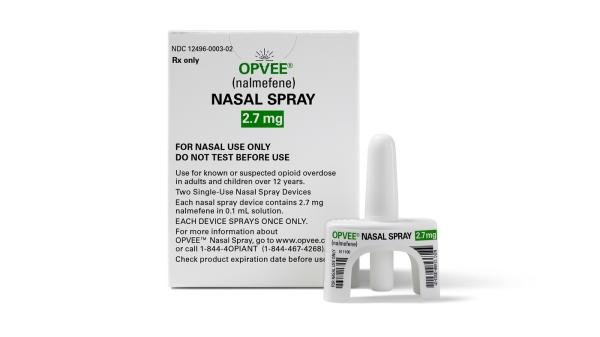Nalmefene Dosage
Applies to the following strengths: 1 mg/mL; 100 mcg/mL; 2.7 mg/0.1 mL
Usual Adult Dose for:
Additional dosage information:
Usual Adult Dose for Reversal of Opioid Sedation
Initial dose: 0.25 mcg/kg intravenously once as an initial dose, followed by 0.25 mcg/kg incremental doses at 2 to 5 minute intervals until the desired degree of opioid reversal is obtained.
If no response after cumulative dose of 1 mcg/kg administered, additional doses are unlikely to provide an effect.
Usual Adult Dose for Opioid Overdose
Initial dose: 0.5 mg/70 kg IV one time. May follow with 1 mg/70 kg IV administered 2 to 5 minutes after initial dose. If no response after 1.5 mg/70 kg administered, additional doses are unlikely to provide an effect.
If there is reasonable suspicion of opioid dependency, an initial challenge dose of 0.1 mg/70 kg IV should be administered. If, after 2 minutes, there is no withdrawal response the recommended dosing should be followed.
If IV access is unavailable, administer 1 mg subcutaneously or intramuscularly.
Renal Dose Adjustments
The clearance of nalmefene is significantly reduced (27%) in renal dysfunction. A dosage adjustment is not necessary for the treatment of a single episode of opioid antagonism. However, incremental doses should be delivered slowly (over 1 minute) in cases of severe renal dysfunction. Rapid administration, in this patient population, may increase the incidence of hypertension and dizziness.
Liver Dose Adjustments
Although the pharmacokinetic disposition is altered in patients with hepatic dysfunction, no dosage adjustments are necessary since nalmefene is administered as an acute course of therapy.
Dose Adjustments
If necessary, the dose may be administered IM or subcutaneously. The onset of action with IM or subcutaneous administration should occur within 5 to 15 minutes.
Precautions
Nalmefene, like all drugs in this class, is not the primary therapy for ventilatory failure. In most emergency settings, therapy with nalmefene should follow, not precede, the establishment of a patent airway, ventilatory assistance, administration of oxygen, and establishment of circulatory access.
Accidental overdose with long acting opioids (such as methadone and levo-alpha-acetylmethadol) may result in prolonged respiratory depression. Respiratory depression in both the postoperative and overdose setting may be complex and involve the effects of anesthetic agents, neuromuscular blockers, and other therapies. While nalmefene has a longer duration of action than naloxone in fully reversing doses, the prescriber should be aware that a recurrence of respiratory depression is possible, even after an apparently adequate initial response to nalmefene treatment. Patients treated with nalmefene should be observed until, in the opinion of the prescriber, there is no reasonable risk of recurrent respiratory depression.
Caution should be used when administering nalmefene to patients at risk of cardiovascular complication or in patients who have received cardiotoxic medications. Opioid reversal has been associated with pulmonary edema, cardiovascular instability, hypotension, hypertension, ventricular tachycardia, ventricular fibrillation, and excessive mortality in patients at high risk for cardiovascular complications.
Nalmefene administration may precipitate acute and prolonged withdrawal symptoms in opioid dependent patients or following surgery involving high doses of opioids.
Nalmefene therapy may not completely reverse buprenorphine-induced respiratory depression.
The safety and efficacy of nalmefene in pediatric patients has not been determined.
Dialysis
The clearance of nalmefene is significantly reduced (27%) in renal dysfunction. A dosage adjustment is not necessary for the treatment of a single episode of opioid antagonism. However, incremental doses should be delivered slowly (over 1 minute) in cases of severe renal dysfunction. Rapid administration, in this patient population, may increase the incidence of hypertension and dizziness.
More about nalmefene
- Check interactions
- Compare alternatives
- Pricing & coupons
- Side effects
- During pregnancy
- Drug class: antidotes
- Breastfeeding
Patient resources
Other brands
Professional resources
Other brands
Related treatment guides
Further information
Always consult your healthcare provider to ensure the information displayed on this page applies to your personal circumstances.


